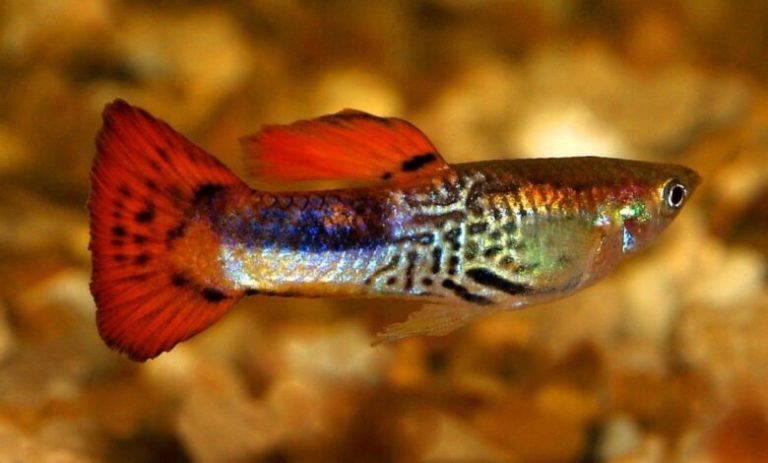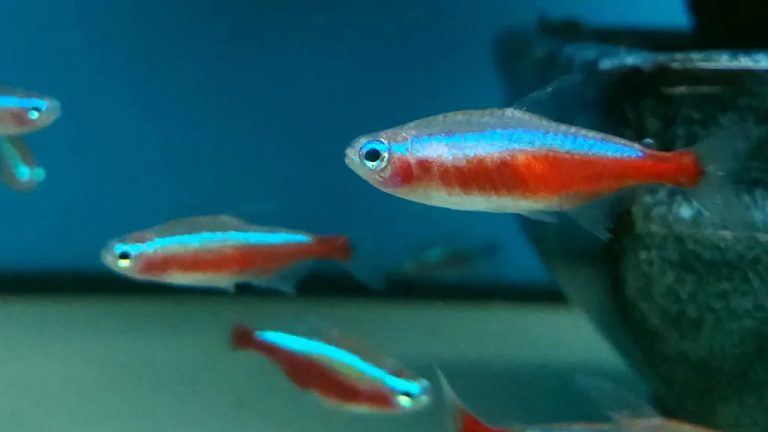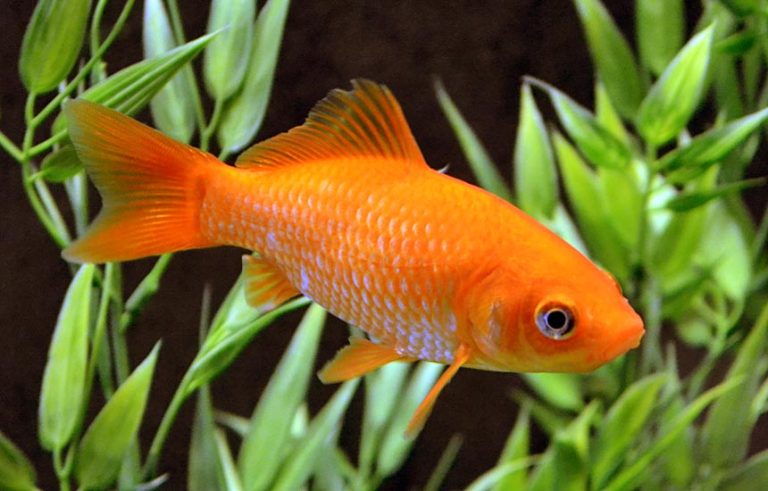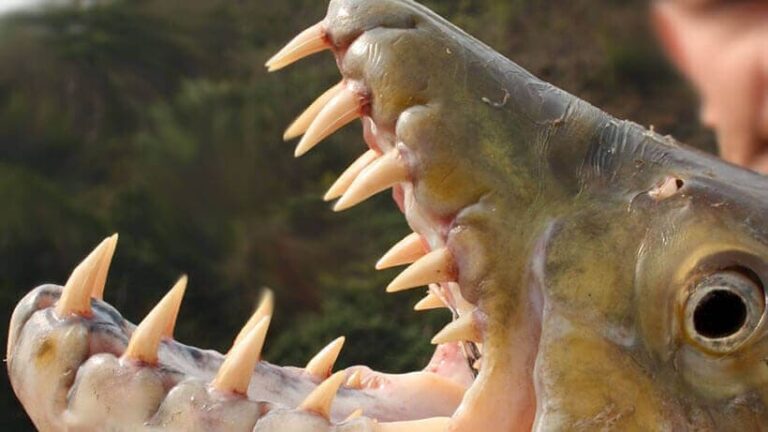Rainbow Shark
The Rainbow Shark, scientifically known as Epalzeorhynchos frenatum, has intrigued and captivated aquarists for years, and it’s not hard to see why. This enigmatic creature, with its sleek, elongated dark body contrasted by striking red fins, resembles the fearsome oceanic sharks that have captivated our imagination for ages. Yet, in a delightful twist of nature, this creature is not the predatory marine species its name suggests.
Instead, it hails from the freshwater realms and belongs to the minnow family, a far cry from the great white or hammerhead sharks of the deep blue. Originating from the rivers and streams of Southeast Asia, the Rainbow Shark thrives in swift moving waters, weaving between submerged rocks and dense vegetation, a behavior replicated in home aquariums.
However, while their appearance is charming and they add a touch of vibrancy to any tank, Rainbow Sharks are not ideal for beginners. Their territorial tendencies mean they can become aggressive, especially in cramped spaces or with the wrong tank mates. As such, they demand a certain level of knowledge and expertise in fishkeeping to ensure they coexist peacefully with other inhabitants.
Moreover, their unique dietary and environmental needs further underline the necessity for a well-informed approach to their care. For those willing to invest the time and effort to understand these magnificent creatures, the Rainbow Shark can be a rewarding, standout addition to a diverse freshwater aquarium. With proper care and a suitable environment, they can offer a dynamic, interactive experience for both seasoned and budding aquarists, capturing the essence of the wild in the heart of your living space.
Rainbow Shark Species Summary:
| Scientific Name: | Epalzeorhynchos frenatum |
| Origin: | Southeast Asia, primarily Thailand |
| Diet: | Omnivore (primarily feeds on algae and plant material, but also benefits from protein sources like insects, crustaceans, and worms) |
| Behavior: | Semi-aggressive, especially when mature |
| Behavior Towards Their Own Species: | Highly territorial, especially with other bottom dwellers and similar looking species. Often aggressive towards its own kind unless in a very spacious environment. |
| Swimming Zone: | Bottom |
| Water Temperature: | 72-79°F (22-26°C) |
| Water Hardness: | 5-11 dGH |
| pH Level: | 6.5 – 7.5 |
| Minimum Aquarium Volume: | 30 gallons (115 liters) for a single specimen. However, larger tanks (50-55 gallons or 190-210 liters) are preferable. |
| Adult Size: | Typically around 6 inches (15 cm) but can vary |
| Reproduction: | Egg layers, but breeding in home aquariums is rare due to territorial nature and the need for specific conditions. |
| Lifespan: | 5 – 8 years, though can live longer with optimal care |
| Care: | Intermediate. Requires a spacious tank with numerous hiding spots, proper water conditions, and a balanced diet to thrive. Close attention to tank mate compatibility is essential due to their territorial nature. |
Tank Size
Rainbow Sharks, with their dynamic personalities and territorial nature, require an adequately sized aquatic playground to truly thrive. The absolute minimum recommended tank size is 30 gallons (or roughly 115 liters). This provides the basic footprint they need to move, explore, and establish a territory. However, as any experienced aquarist would attest, bigger is often better, especially for active swimmers and bottom dwellers like the Rainbow Shark.
If you’re aiming to create a comfortable environment where your Rainbow Shark can exhibit natural behaviors, a tank size of 50-55 gallons (or between 190-210 liters) is much more appropriate. In such a space, not only does the Rainbow Shark have sufficient room to navigate and claim territories, but the larger volume also aids in maintaining stable water parameters, reducing the risks of rapid fluctuations that can stress the fish.
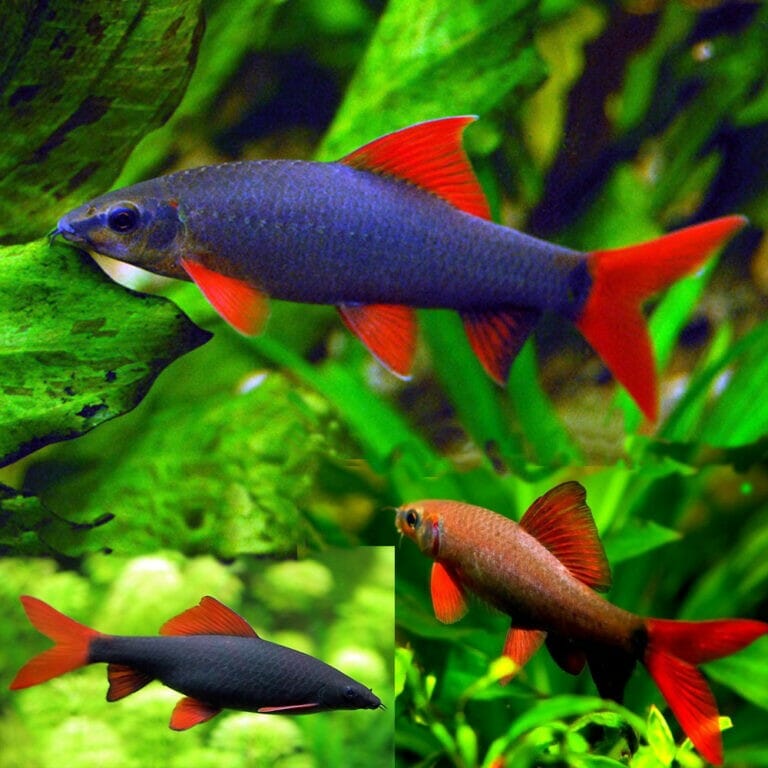
Water Parameters
- Temperature: The Rainbow Shark is accustomed to tropical freshwater settings, which is why a temperature range of 72-79°F (22-26°C) is ideal. Consistent temperatures within this range mimic their native habitats, promoting healthy metabolic activity and reducing stress.
- pH Level: The water’s acidity or alkalinity is measured by its pH level. For Rainbow Sharks, a pH level between 6.5 and 7.5 is optimal. This slightly acidic to neutral range is close to the conditions of the rivers and streams they originate from. Regularly testing the pH and ensuring it remains stable within this range is crucial to avoid potential health issues.
- Hardness: Water hardness refers to the concentration of dissolved minerals in the water. The Rainbow Shark prefers a water hardness between 5-11 dGH (degrees of general hardness). This level ensures that the water contains the necessary minerals for the shark’s health, without being overly mineral-rich, which could be detrimental.
To sum it up, while these specific guidelines offer a blueprint for the ideal care of a Rainbow Shark, the key to a healthy and happy fish lies in the consistency of the environment. Regular water testing, routine maintenance, and understanding the nuances of your specific aquarium ecosystem are crucial elements in ensuring your Rainbow Shark’s well-being.
Diet and Feeding
Rainbow Sharks, with their flexible dietary habits, can be considered the epicureans of the freshwater world. Being omnivores, their diet in the wild consists of a mix of plant matter and small aquatic organisms. Replicating this diverse diet in captivity is the key to ensuring they maintain vibrant colors, optimal health, and active behavior.
- Primary Diet: High-Quality Sinking Pellets or Granules:
- Why Sinking Food? Rainbow Sharks are primarily bottom dwellers, which means they naturally forage in the substrate for food. Sinking pellets and granules cater to this instinctual behavior, allowing them to feed in a manner they’re accustomed to.
- Quality Matters: It’s essential to invest in high-quality food brands that offer well-balanced nutritional content. Look for foods enriched with essential vitamins, minerals, and proteins to ensure the fish’s overall well-being.
- Supplementary Foods:
- Live Foods: These are crucial for mimicking the Rainbow Shark’s natural diet. Organisms such as brine shrimp or bloodworms not only provide essential proteins but also stimulate the shark’s hunting instincts, keeping them mentally engaged.
- Blanched Vegetables: Occasional treats like blanched zucchini slices or peas can be an excellent source of vital fibers and nutrients. These veggies also promote digestive health, reducing the risk of blockages or constipation. Before feeding, ensure the vegetables are soft enough to be consumed easily and are devoid of any added chemicals or seasonings.
- Algae Wafers: Rainbow Sharks often graze on algae in their natural habitats. Offering them algae wafers caters to this instinct, ensuring they get a mix of plant and animal matter in their diet.
- Feeding Frequency:
- Feeding your Rainbow Shark once or twice a day maintains a stable metabolism. The key is moderation. Overfeeding can lead to water pollution due to uneaten food, which, in turn, can result in health issues for the fish.
- A common rule of thumb is to offer only what they can consume within 2-3 minutes. Observing their eating habits over time will give you a good idea of the right quantity to offer during each feeding session.
In conclusion, a diverse and balanced diet is essential for the health and happiness of your Rainbow Shark. It ensures they get all the necessary nutrients, mimics their natural feeding habits, and keeps them active and engaged in their environment. Regularly varying their diet and ensuring cleanliness in the tank will pave the way for a long, healthy life for these captivating creatures.
Tank Setup
Creating a habitat that mirrors the Rainbow Shark’s natural environment is crucial for its well-being. A thoughtfully designed tank can reduce stress, curb aggressive tendencies, and encourage natural behaviors, ensuring your Rainbow Shark feels right at home.
- Substrate: Fine Gravel or Sand:
- Mimicking the Natural Habitat: In their native habitats, Rainbow Sharks navigate riverbeds and stream bottoms scattered with varying sizes of gravel and sand. Introducing a fine gravel or sandy substrate in the aquarium not only replicates their natural setting but also facilitates their instinctual behavior of sifting through the bottom.
- Safety First: Opt for smooth-edged gravel. Sharp or jagged substrate can injure the fish, especially since they like to rummage and sometimes dig.
- Decor – Emphasis on Hiding Spots:
- Caves and Rock Formations: These structures are essential for Rainbow Sharks. In the wild, they often utilize rocky crevices as refuge. In the tank, caves or rock formations offer the fish a sense of security and a place to retreat, especially during periods of stress or rest.
- Reducing Aggression: By providing multiple hiding spots, you’re allowing your Rainbow Shark to establish and mark its territory. This can significantly reduce skirmishes with other tank inhabitants, as the shark will have its ‘domain’ to retreat to.
- Aesthetics and Functionality: While ensuring these decors serve their functional purposes, you can also strategically place them to enhance the overall aesthetic appeal of your aquarium, creating an intricate and captivating underwater landscape.
- Plants – A Touch of Green:
- Java Fern: A robust plant that is not easily uprooted, making it a great choice for a tank with an active Rainbow Shark. It also adds a beautiful green backdrop to the aquarium.
- Anubias: With its thick leaves and sturdy nature, Anubias can withstand occasional nibbling or foraging from the Rainbow Shark. It can be anchored to rocks or driftwood, elevating the visual appeal of the setup.
- Vallisneria: This grass-like plant grows tall and can create dense thickets, providing additional hiding spots and mimicking the reed beds found in the shark’s native habitats.
- Planting Tip: Given the Rainbow Shark’s tendency to dig or forage, consider using plant weights or root tabs to keep plants anchored. Alternatively, choose plants that can be attached to decor, like Anubias or Java Fern.
In essence, setting up a tank for a Rainbow Shark is a balance between aesthetics and functionality. Every element introduced should serve a purpose, either to replicate the fish’s natural environment, reduce stressors, or provide stimuli. A well-set tank will not only ensure the well-being of the Rainbow Shark but also create a visual masterpiece for you to enjoy.
Behavior
Rainbow Sharks, despite their stunning appearance, come with a temperament that demands respect and understanding from their caregivers. These fish are known for their pronounced territorial tendencies, which can manifest as aggression, especially when they feel their space is threatened.
- Aggression Triggers: Their territorial nature is heightened when they encounter fish that bear a resemblance to them, be it in color, shape, or swimming habits. This behavior is rooted in their instinct to assert dominance over similar species to ensure their survival and breeding rights in the wild.
- Bottom Dwellers: Their preference for the tank bottom further complicates matters. They often claim a particular section of the tank as their own, zealously defending it against other bottom-dwelling species.
Suitable Tank Mates
Choosing tank mates for Rainbow Sharks is a delicate balancing act. Given their territorial disposition, selecting companions that neither resemble them nor vie for the same tank regions is crucial.
- Larger Tetras (e.g., Congo Tetras): These active mid-water swimmers are less likely to invade the Rainbow Shark’s territory, reducing the potential for conflicts.
- Barbs: Most barbs are fast swimmers and occupy the middle water column. However, avoid species like the Red-Tailed or Red-Finned Sharks, as they can be mistaken as rivals by the Rainbow Shark.
- Danios: Known for their rapid swimming and peaceful nature, danios make for good tank mates, staying clear of the bottom and the Rainbow Shark’s claimed territory.
- Gouramis: These calm, larger fish often swim in the middle or top sections of the tank, steering clear of the Rainbow Shark’s domain.
- Loaches (e.g., Clown Loach): While they are bottom dwellers, many loaches can coexist with Rainbow Sharks, provided the tank is spacious enough. But always monitor their interactions, especially initially.
- Rainbowfish: These vibrant, mid to top level swimmers can add color to your tank without inciting the territorial wrath of the Rainbow Shark.
Tank Mates to Avoid
- Small, Delicate Fish: Their size and frailty make them easy targets for the more aggressive Rainbow Shark.
- Other Rainbow Sharks: Keeping multiple Rainbow Sharks is a challenge. Unless you have a very large tank (100+ gallons or 380+ liters) with ample hiding spots, it’s advisable to keep just one. Even in spacious environments, there’s a risk of intense territorial disputes.
- Other Territorial Bottom Dwellers: This includes certain species of catfish and cichlids. Introducing them can lead to fierce battles for territory, causing stress and potential harm to both parties.
In conclusion, while the Rainbow Shark’s territorial nature might seem like a challenge, with careful planning and species selection, they can coexist harmoniously with a variety of other fish. Observing interactions, especially during the initial introduction phase, and being ready to intervene or rearrange tank setups if necessary, ensures a peaceful aquatic community.

Breeding
The Rainbow Shark, while a beautiful specimen, presents several challenges for those looking to breed them within the confines of a home aquarium. Their naturally aggressive and territorial tendencies mean that careful planning is paramount to achieve successful breeding.
- Spacious Tank: Breeding requires an environment where both male and female Rainbow Sharks can establish territories without frequent skirmishes. A minimum of a 100-gallon tank (or 380 liters) is advised, ensuring ample space for hiding and escape routes.
- Water Conditions: Just as crucial as space is the water’s quality and parameters. Maintaining a temperature closer to the higher end of their comfort zone (around 77-79°F or 25-26°C) may encourage spawning. Consistent pH levels, as well as optimal hardness, play a role in creating an inviting breeding environment.
- Identifying Sexes: Males generally have a more streamlined body and a brighter color, while females are slightly bulkier with a rounder abdomen. Distinguishing between them is essential for breeding purposes.
- Reduced Aggression: Introducing barriers or dividers can help minimize aggressive interactions between the sharks, especially when first introduced. Over time, as they get accustomed to each other’s presence, these dividers can be gradually removed.
- Diet: Offering a rich, varied diet, including live foods, can condition the Rainbow Sharks for breeding. Nutrient-dense foods can boost their overall health and increase the chances of successful reproduction.
- Spawning: While spawning behaviors can be observed, such as chasing and nudging, it’s quite rare for eggs to be laid and successfully hatch in a home aquarium. Even if they do, the survival rate of the fry is generally low due to the presence of other fish and the natural tendencies of Rainbow Sharks to guard their territory zealously.
The Rainbow Shark is undoubtedly a mesmerizing addition to any freshwater aquarium. Their striking colors and active behaviors can be both a joy and a challenge for aquarium enthusiasts. While their care demands a level of experience and understanding, the rewards are immense. The sight of a healthy, vibrant Rainbow Shark darting around its well-designed habitat is truly a testament to the wonders of aquatic life.
To successfully keep a Rainbow Shark, one must be prepared for its idiosyncrasies—its territorial nature, specific tank requirements, and the careful selection of tank mates. When these factors are taken into account, and with regular care and attention, the Rainbow Shark will not only survive but thrive, showcasing its fascinating behaviors and captivating beauty for years to come.

